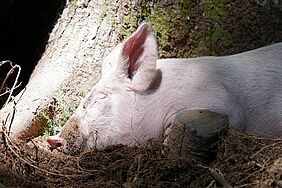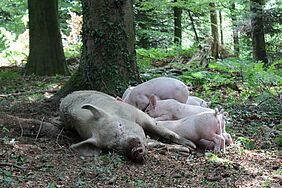As part of "SchweinErleben", three sows – and, depending on the season, their piglets – can be observed in a temporary outdoor enclosure at the Panoramahof in Meggen since spring 2023. With this project, the Albert Koechlin Foundation (AKS) is drawing attention to an animal that we use but hardly know. "With this natural and educational project, we can familiarise children, young people and adults with pigs," says Marianne Schnarwiler, Managing Director of the AKS.
Unique approach
In addition to specific educational programmes for school classes, "SchweinErleben" also includes a research section, for which the AKS is collaborating with FiBL. "The project gives both the public and researchers unique access to pigs," says Mirjam Holinger, Co-leader of the Animal Housing and Livestock Breeding Group at FiBL. "In order to study the behaviour and possible needs of animals, it is often useful to observe these animals in their natural environment. Domestic pigs are descended from wild boar - and so forests and, to a lesser extent, meadows are considered to be the original environment of pigs." The findings can be used to design husbandry systems that are more species-appropriate and better tailored to the pigs' needs.
Scientists sought
During the project period, the pigs on the panoramic farm are observed with over 20 video cameras. Is there still a wild boar with all its behaviour and needs behind the pink skin of the domestic pigs? To find out, researchers from the general public are now being asked to watch short videos of the curious animals online - and then answer a few research questions. Interested people can participate immediately on the Citizen Science Zurich website. By taking part, they help to gather information about the behaviour and social structure of pigs and find answers to scientific questions that have yet to be answered. Various surprises await the most diligent Citizen Science participants, such as exclusive guided tours of "SchweinErleben" on site.
Further information
Contact
Mirjam Holinger, Co-leader of the Group Animal Housing & Livestock Breeding, FiBL Switzerland
Links
- lab.citizenscience.ch: Participation "SchweinErleben"
- schweinerleben.ch: Project website
- picturepark.com: Further images for download
Partners
- Albert Koechlin Stiftung
- Natur-Museum Luzern






